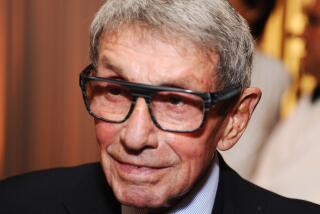ON THE WATERFRONT
- Share via
Your review of Marlon Brando’s autobiography (Sept. 18) repeats an old revisionist chestnut about Elia Kazan’s movie, “On the Waterfront.” “Kazan and Budd Schulberg, who wrote the script,” your reviewer writes, “had both been cooperating witnesses for (the House Committee on Un-American Activities). The movie is a defense of their position.”
Here’s what really happened, though facts often get in the way of what some people want to believe.
Elia Kazan came to me in 1951 and suggested we do a picture in the East with a social theme. We discussed the Trenton Six, the case of young blacks accused in a (New Jersey) grocery-store killing who were being railroaded to their deaths. I spent a few weeks in Trenton checking it out. I got the picture it wasn’t a clear-cut case. Then I mentioned the waterfront. I had done a screenplay based on a newspaper series about the longshoremen’s union. Kazan was interested. Coincidentally, he had worked with Arthur Miller on a waterfront project that had fallen through.
With Kazan urging me on (with absolutely no mention of answering his House Un-American Activities Committee critics), I threw myself back into the waterfront. I was drawn to St. Francis Xavier Church, and the Rev. John Corridan, and his longshoremen disciples. The film project because a potential weapon on the side of social justice. In the course of a year and a half’s association with the reform element in the International Longshoremen’s Union, I sat in on Father John’s counseling the men when he was urging them to testify on waterfront crime to the Waterfront Commission. They were afraid for their lives if they got up and told the truth. But Father Corridan felt their testimony was needed to break the hold of the mob on the terrorized dockworkers.
I reported to Kazan on what I was learning. He came down and met Father Corridan and the men on edge about testifying. Out of this real crisis the film’s climax evolved. I attended every day of the waterfront hearings. I wrote the film’s ending out of this experience. It was my relationship with an unforgettable labor priest urging his flock to defy the mob in the name of democratic unionism that gave substance to the work.
The best you can say for the revisionists with their convenient theories is that Kazan’s direction may have been energized by some sense that the climax justified his own position before HUAC. But to isolate that emotion as the inspiration for our film is to put the cart before the horse.
BUDD SCHULBERG, WESTHAMPTON BEACH, N.Y.
Reviewer David Freeman responds: “On the Waterfront” dramatizes a situation in which the naming of names is justifiable and brave. The director and writer of the film were cooperating witnesses for HUAC. I, and others, see a connection there. But I take Schulberg’s point.
*
In referring to Anna Kashfi’s “spiteful” book, “Brando for Breakfast” (Sept. 18), you omitted the co-author’s name: E.P. Stein. Curiously, in the original review (Sept. 9, 1979), you committed the same oversight. It’s E.P. Stein--got it? Where can authors count on respect if not in Book Reviews? Anyhow, Anna Kashfi was married to Marlon Brando. In her case, spite makes right.
FRANCIS SINCLAIR, BEVERLY HILLS
More to Read
Only good movies
Get the Indie Focus newsletter, Mark Olsen's weekly guide to the world of cinema.
You may occasionally receive promotional content from the Los Angeles Times.










